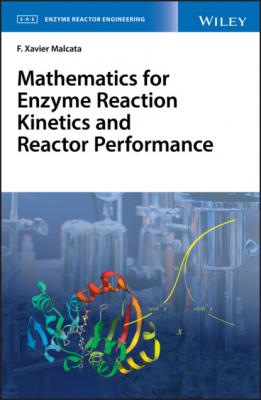Mathematics for Enzyme Reaction Kinetics and Reactor Performance. F. Xavier Malcata
Читать онлайн.| Название | Mathematics for Enzyme Reaction Kinetics and Reactor Performance |
|---|---|
| Автор произведения | F. Xavier Malcata |
| Жанр | Химия |
| Серия | |
| Издательство | Химия |
| Год выпуска | 0 |
| isbn | 9781119490333 |
(4.203)
that implies
because any other value of bT Va would make the left‐hand side positive for it being a square. Equation (4.204) implies, in turn,
(4.205)
since no restriction was imposed on b; therefore, aT Va = 0 implies Va =0n×1, besides Va =0n×1 implying aT Va = 0, as seen previously – so Va =0n×1 and aT Va = 0 are equivalent statements. Consequently, Va ≠0n×1 accounts for the inequality case in Eq. (4.196), i.e. aT Va > 0.
If P denotes an (n × m) matrix, then the (m × m) matrix PT VP is (real) symmetric, positive semidefinite; in fact,
(4.206)
as per Eqs. (4.110) and (4.120) – so PT VP abides to the symmetry requirement because, by hypothesis, VT = V, i.e.
Furthermore, the scalar
(4.208)
– where a and b denote (m × 1) and (n × 1) column vectors, respectively, and Eqs. (4.57) and (4.120) were taken advantage of, will be positive if b ≡ Pa ≠ 0n × 1 and nil if b ≡ Pa = 0n × 1, in agreement with the foregoing derivation, coupled with Eqs. (4.196) and (4.197); this is so because V is positive semidefinite by hypothesis. In other words,
– which, together with Eq. (4.207), confirms the full original statement on PT VP, i.e. a symmetric and positive definite matrix.
In the particular case of V = In, Eq. (4.196) degenerates to
(4.210)
at the expense of the n‐dimensional analogue of Eq. (3.8) – with the aid of Eq. (4.64) and explicitation of (n × 1) matrix a; hence, In is positive semidefinite as per Eq. (4.196). One may therefore resort directly to Eq. (4.209) to write
encompassing (m × 1) matrix a; and Eq. (4.211) may be algebraically simplified to
in view of Eq. (4.64). Inspection of Eq. (4.212) confirms that PT P is necessarily a positive semidefinite matrix, while
(4.213)
as per Eq. (4.120), or else
(4.214)
in view of Eq. (4.110) – thus confirming its symmetry.
5 Tensor Operations
A tensor, τ, consists on the extrapolation of a vector to a three‐dimensional space, based on each of its three directional components – so it has no geometrical representation, being defined solely by its components in a Cartesian R9 domain; its notation resorts normally to matrix form, viz.
– so it can be formed by juxtaposition of three vectors of the type labeled as Eq. (3.6), or else
using Eq. (3.1) as template. The unit tensors, φi,j (i = x,y,z; j = x,y,z), are, in turn, defined as arrays of nine components (all of which are zero but one, equal to unity), according to
